Effects of Thai Local Ingredient Odorants, Litsea cubeba and Garlic Essential Oils, on Brainwaves and Moods
Abstract
1. Introduction
2. Results
2.1. Gas Chromatography–Mass Spectrometry (GC–MS) Analyses of Litsea Cubeba and Garlic Oils
2.2. Effects of Essential Oil Inhalation on Brainwaves and Moods
3. Discussion
4. Materials and Methods
4.1. Subject
4.2. Essential Oil Preparations, GC–MS Analyses and Administrations
4.3. Electroencephalography
4.4. Score of Moods State Response
4.5. Data Analyses and Statistics
5. Conclusions
Supplementary Materials
Author Contributions
Funding
Institutional Review Board Statement
Informed Consent Statement
Data Availability Statement
Acknowledgments
Conflicts of Interest
Sample Availability
References
- Research, G.V. Functional Foods Market Size, Share and Trends Analysis Report by Ingredient, by Product, by Application, and Segment Forecasts, 2019–2025. Available online: https://www.grandviewresearch.com/industry-analysis/functional-food-market (accessed on 30 March 2021).
- Kanchanakunjara, T.; Chantachon, S.; Koseyayotin, M. The Evolution of Thai Curry Pastes. DTC J. 2018, 11, 249–266. [Google Scholar]
- Selim, S.A. Chemical composition, antioxidant and antimicrobial activity of the essential oil and methanol extract of the Egyptian lemongrass Cymbopogon proximus Stapf. Grasas Aceites 2011, 62, 55–61. [Google Scholar] [CrossRef]
- Quintans-Júnior, L.; da Rocha, R.F.; Caregnato, F.F.; Moreira, J.C.; da Silva, F.A.; Araújo, A.A.; dos Santos, J.P.; Melo, M.S.; de Sousa, D.P.; Bonjardim, L.R.; et al. Antinociceptive action and redox properties of citronellal, an essential oil present in lemongrass. J. Med. Food 2011, 14, 630–639. [Google Scholar] [CrossRef] [PubMed]
- Costa, C.A.R.d.A.; Kohn, D.O.; de Lima, V.M.; Gargano, A.C.; Flório, J.C.; Costa, M. The GABAergic system contributes to the anxiolytic-like effect of essential oil from Cymbopogon citratus (lemongrass). J. Ethnopharmacol. 2011, 137, 828–836. [Google Scholar] [CrossRef] [PubMed]
- Ansari Pour, A.; Mehrnia, M.A.; Noshad, M.; Barzegar, H.; Alizadeh Behbahani, B. Antimicrobial effect of garlic essential oil on a number of food-borne pathogens and determination of its chemical composition and antioxidant potential. J. Food Sci. Technol. 2019, 16, 17–29. [Google Scholar]
- Demmig-Adams, B.; Wilson, E.A. Antioxidant, anti-inflammatory, and antimicrobial properties of garlic and onions. Nutr. Food Sci. 2007, 37, 178–183. [Google Scholar]
- Huang, Y.J.; Lu, K.H.; Lin, Y.E.; Panyod, S.; Wu, H.Y.; Chang, W.T.; Sheen, L.Y. Garlic essential oil mediates acute and chronic mild stress-induced depression in rats via modulation of monoaminergic neurotransmission and brain-derived neurotrophic factor levels. Food Funct. 2019, 10, 8094–8105. [Google Scholar] [CrossRef]
- Liju, V.B.; Jeena, K.; Kuttan, R. An evaluation of antioxidant, anti-inflammatory, and antinociceptive activities of essential oil from Curcuma longa. L. Indian J. Pharmacol. 2011, 43, 526–531. [Google Scholar]
- Benammi, H.; El Hiba, O.; Romane, A.; Gamrani, H. A blunted anxiolytic like effect of curcumin against acute lead induced anxiety in rat: Involvement of serotonin. Acta Histochem. 2014, 116, 920–925. [Google Scholar] [CrossRef]
- Kieling, D.D.; Prudencio, S.H. Blends of lemongrass derivatives and lime for the preparation of mixed beverages: Antioxidant, physicochemical, and sensory properties. J. Sci. Food Agric. 2019, 99, 1302–1310. [Google Scholar] [CrossRef]
- Sowndhararajan, K.; Kim, S. Influence of Fragrances on Human Psychophysiological Activity: With Special Reference to Human Electroencephalographic Response. Sci. Pharm. 2016, 84, 724. [Google Scholar] [CrossRef] [PubMed]
- Hasegawa, T.; Nakatani, K.; Fujihara, T.; Yamada, H. Aroma of Turmeric: Dependence on the Combination of Groups of Several Odor Constituents. Nat. Prod. Commun. 2015, 10, 1047–1050. [Google Scholar] [CrossRef] [PubMed]
- Koomhin, P.; Sattayakhom, A.; Chandharakool, S.; Sinlapasorn, J.; Suanjan, S.; Palipoch, S.; Na-Ek, P.; Punsawad, C.; Matan, N. Michelia Essential Oil Inhalation Increases Fast Alpha Wave Activity. Sci. Pharm. 2020, 88, 23. [Google Scholar] [CrossRef]
- Chandharakool, S.; Koomhin, P.; Sinlapasorn, J.; Suanjan, S.; Phungsai, J.; Suttipromma, N.; Songsamoe, S.; Matan, N.; Sattayakhom, A. Effects of Tangerine Essential Oil on Brain Waves, Moods, and Sleep Onset Latency. Molecules 2020, 25, 4865. [Google Scholar] [CrossRef] [PubMed]
- Lehrner, J.; Eckersberger, C.; Walla, P.; Pötsch, G.; Deecke, L. Ambient odor of orange in a dental office reduces anxiety and improves mood in female patients. Physiol. Behav. 2000, 71, 83–86. [Google Scholar] [CrossRef]
- Lehrner, J.; Marwinski, G.; Lehr, S.; Johren, P.; Deecke, L. Ambient odors of orange and lavender reduce anxiety and improve mood in a dental office. Physiol. Behav. 2005, 86, 92–95. [Google Scholar] [CrossRef]
- Schulz, H.; Jobert, M.; Hübner, W.D. The quantitative EEG as a screening instrument to identify sedative effects of single doses of plant extracts in comparison with diazepam. Phytomedicine 1998, 5, 449–458. [Google Scholar] [CrossRef]
- Gottfried, J.A. Central mechanisms of odour object perception. Nat. Rev. Neurosci. 2010, 11, 628–641. [Google Scholar] [CrossRef]
- Moss, M.; Oliver, L. Plasma 1,8-cineole correlates with cognitive performance following exposure to rosemary essential oil aroma. Ther. Adv. Psychopharmacol. 2012, 2, 103–113. [Google Scholar] [CrossRef]
- Kawakami, M.; Aoki, S.; Ohkubo, T. A study of “fragrance” on working environment characteristics in VDT work activities. Int. J. Prod. Econ. 1999, 60-61, 575–581. [Google Scholar] [CrossRef]
- Goel, N.; Kim, H.; Lao, R.P. An Olfactory Stimulus Modifies Nighttime Sleep in Young Men and Women. Chronobiol. Int. 2005, 22, 889–904. [Google Scholar] [CrossRef]
- Zhou, W.; Yoshioka, M.; Yokogoshi, H. Sub-Chronic Effects of (s)-Limonene on Brain Neurotransmitter Levels and Behavior of Rats. J. Nutr. Sci. Vitaminol. 2009, 55, 367–373. [Google Scholar] [CrossRef] [PubMed]
- Charret, T.S. Citral Effects on the Expression Profile of Brain-Derived Neurotrophic Factor and Inflammatory Cytokines in Status Epi-lepticus-Induced Rats Using the Lithium-Pilocarpine Model. Available online: https://www.liebertpub.com/doi/10.1089/jmf.2020.0073 (accessed on 30 March 2021).
- Manayi, A.; Nabavi, S.M.; Daglia, M.; Jafari, S. Natural terpenoids as a promising source for modulation of GABAergic system and treatment of neurological diseases. Pharmacol. Rep. 2016, 68, 671–679. [Google Scholar] [CrossRef] [PubMed]
- Toller, S.V.; Behan, J.; Howells, P.; Kendal-Reed, M.; Richardson, A.; Warwick Human Chemoreception Research Group. An analysis of spontaneous human cortical EEG activity to odours. Chem. Senses 1993, 18, 1–16. [Google Scholar] [CrossRef]
- Sayorwan, W.; Siripornpanich, V.; Piriyapunyaporn, T.; Hongratanaworakit, T.; Kotchabhakdi, N.; Ruangrungsi, N. The effects of lavender oil inhalation on emotional states, autonomic nervous system, and brain electrical activity. J. Assoc. Med. Sci. 2012, 95, 598–606. [Google Scholar]
- Cho, H.M.; Yu, B.; Sowndhararajan, K.; Jung, J.W.; Jhoo, J.-W.; Jin, C.W. Effect of Essential Oil from San-Jo-In (Zizyphus jujuba Mill. seeds) on Human Electroencephalographic Activity. J. Life Sci. 2013, 23, 1170–1176. [Google Scholar] [CrossRef]
- Mathew, B.; Biju, R. Neuroprotective effects of garlic a review. Libyan J. Med. 2008, 3, 23–33. [Google Scholar]
- Akinyemi, A.; Faboya, L.; Awonegan, A.; Olayide, I.; Anadozie, S.; Oluwasola, T. Antioxidant and Anti-Acetylcholinesterase Activities of Essential Oils from Garlic (Allium Sativum) Bulbs. Int. J. Plant. Res. 2018, 31, 1000397. [Google Scholar]
- Tang, Q.; Ren, H.; Yan, L.; Quan, X.; Xia, H.; Luo, H. Diallyl trisulfide regulates rat colonic smooth muscle contractions by inhibiting L-type calcium channel currents. J. Pharmacol. Sci. 2018, 137, 299–304. [Google Scholar] [CrossRef]
- Kim, M.; Sowndhararajan, K.; Park, S.J.; Kim, S. Effect of inhalation of isomers, (+)-α-pinene and (+)-β-pinene on human electroencephalographic activity according to gender difference. Eur. J. Integr. Med. 2018, 17, 33–39. [Google Scholar] [CrossRef]
- Sowndhararajan, K.; Cho, H.; Yu, B.; Song, J.; Kim, S. Effect of inhalation of essential oil from Inula helenium L. root on electroencephalographic (EEG) activity of the human brain. Eur. J. Integr. Med. 2016, 8, 453–457. [Google Scholar] [CrossRef]
- Russell, J.A. A circumplex model of affect. J. Pers. Soc. Psychol. 1980, 39, 1161–1178. [Google Scholar] [CrossRef]
- Russell, J.A. Chapter 4—MEASURES OF EMOTION. In The Measurement of Emotions; Plutchik, R., Kellerman, H., Eds.; Academic Press: Cambridge, MA, USA, 1989; pp. 83–111. [Google Scholar]
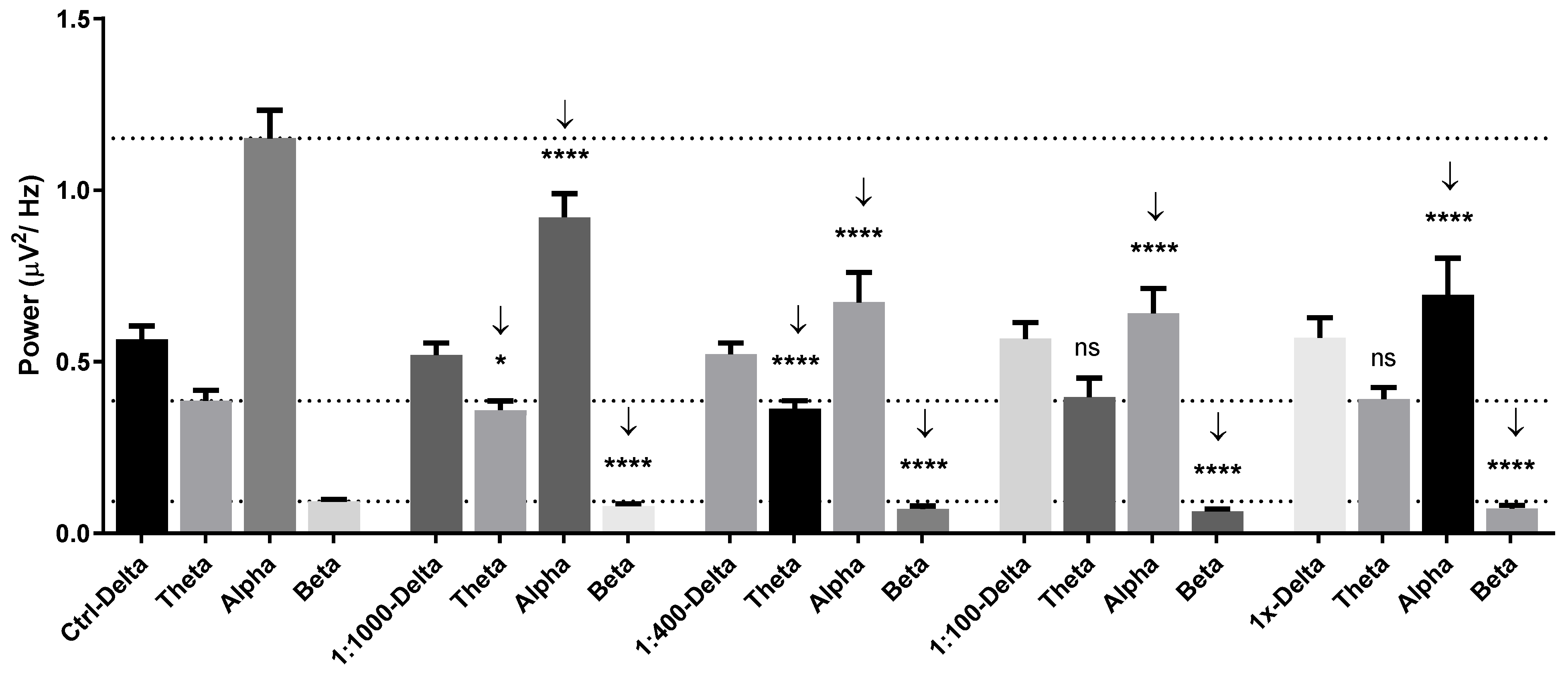
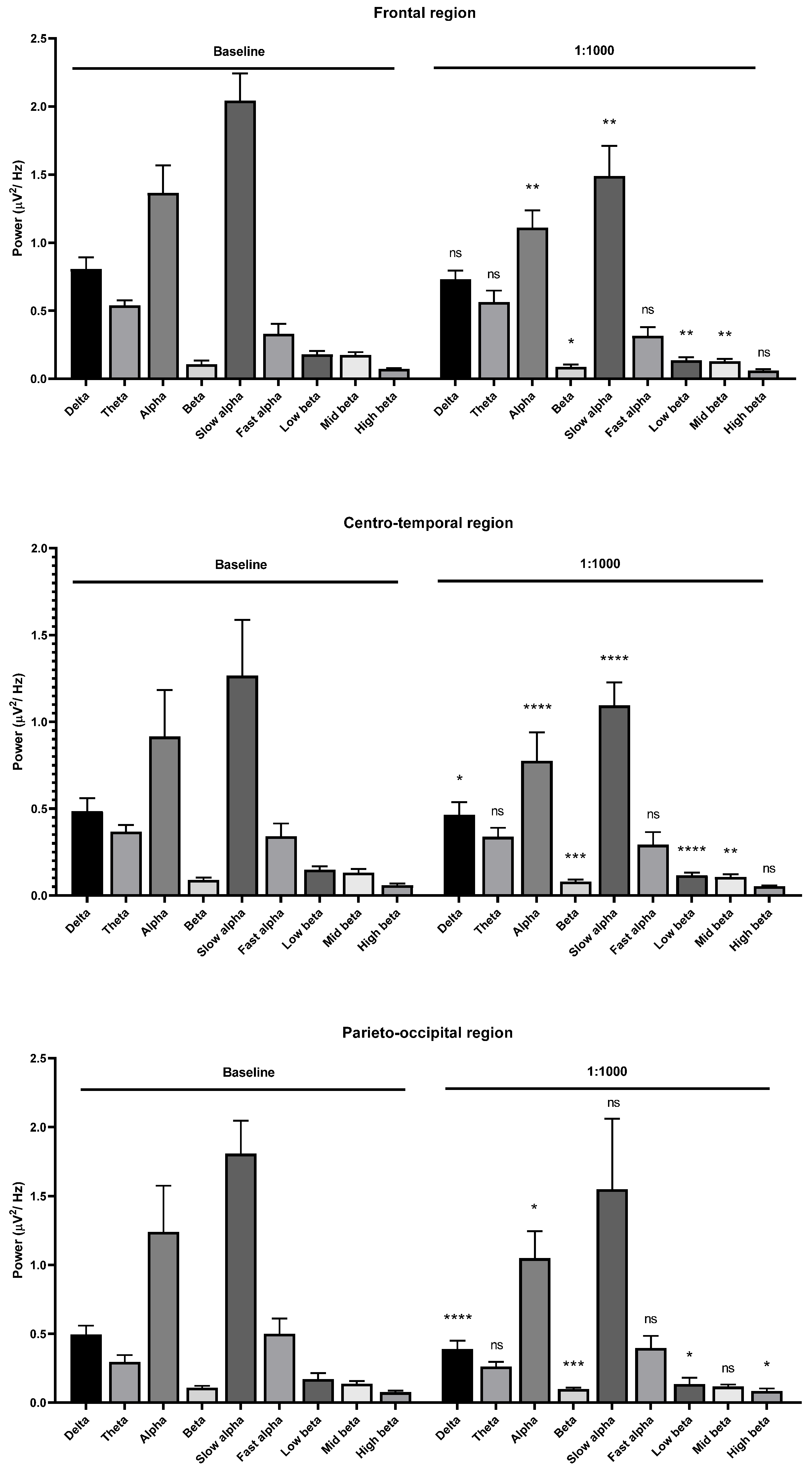

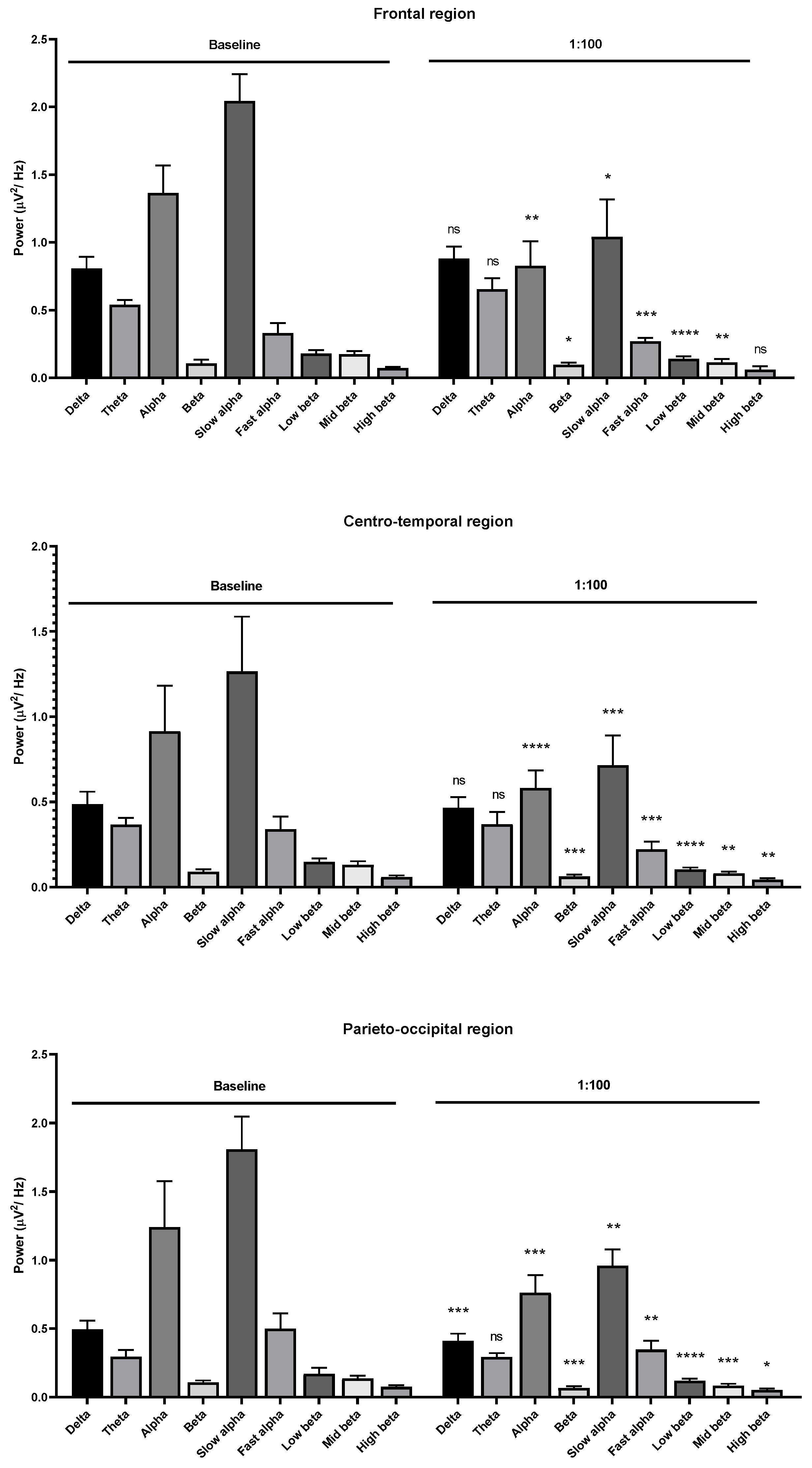
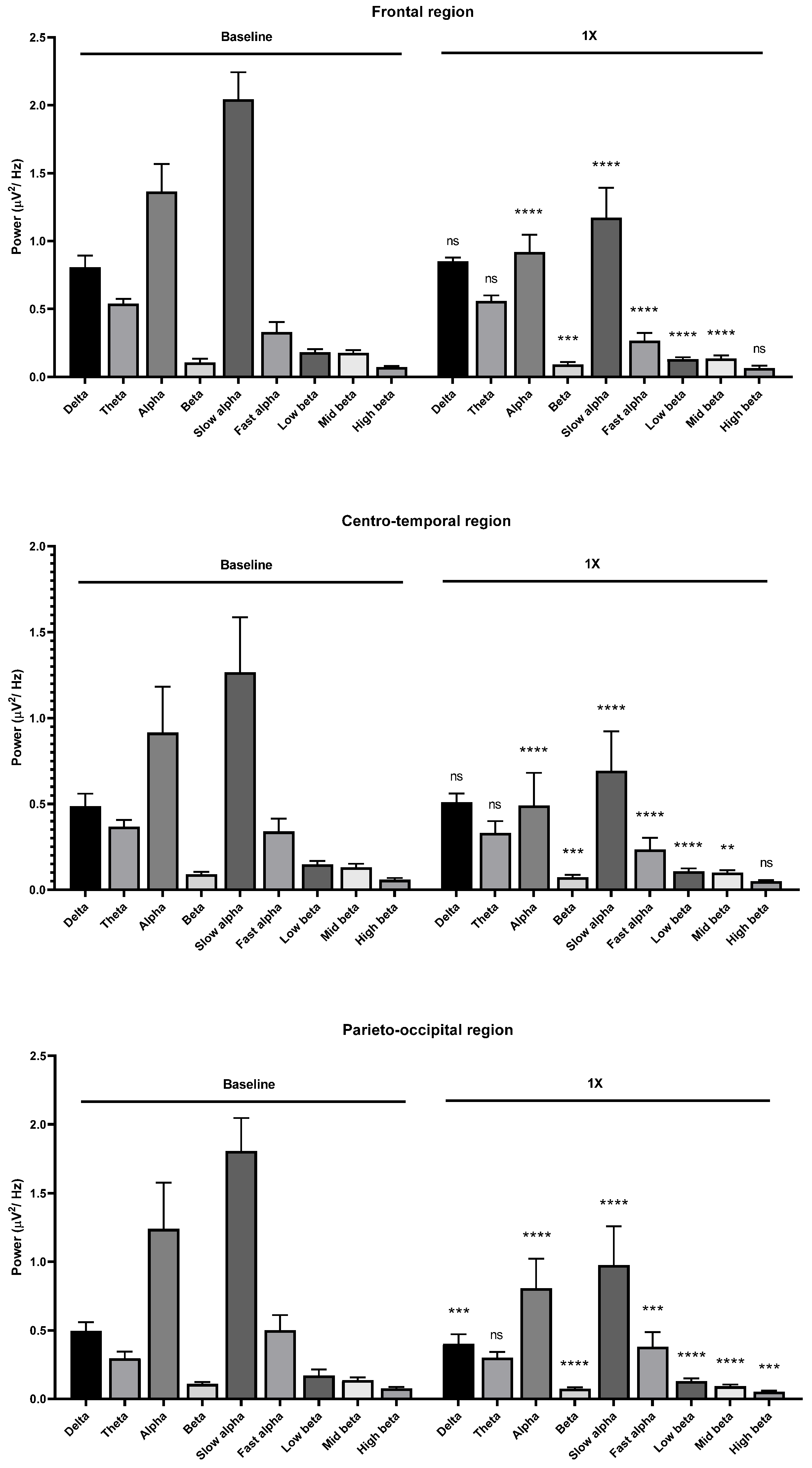
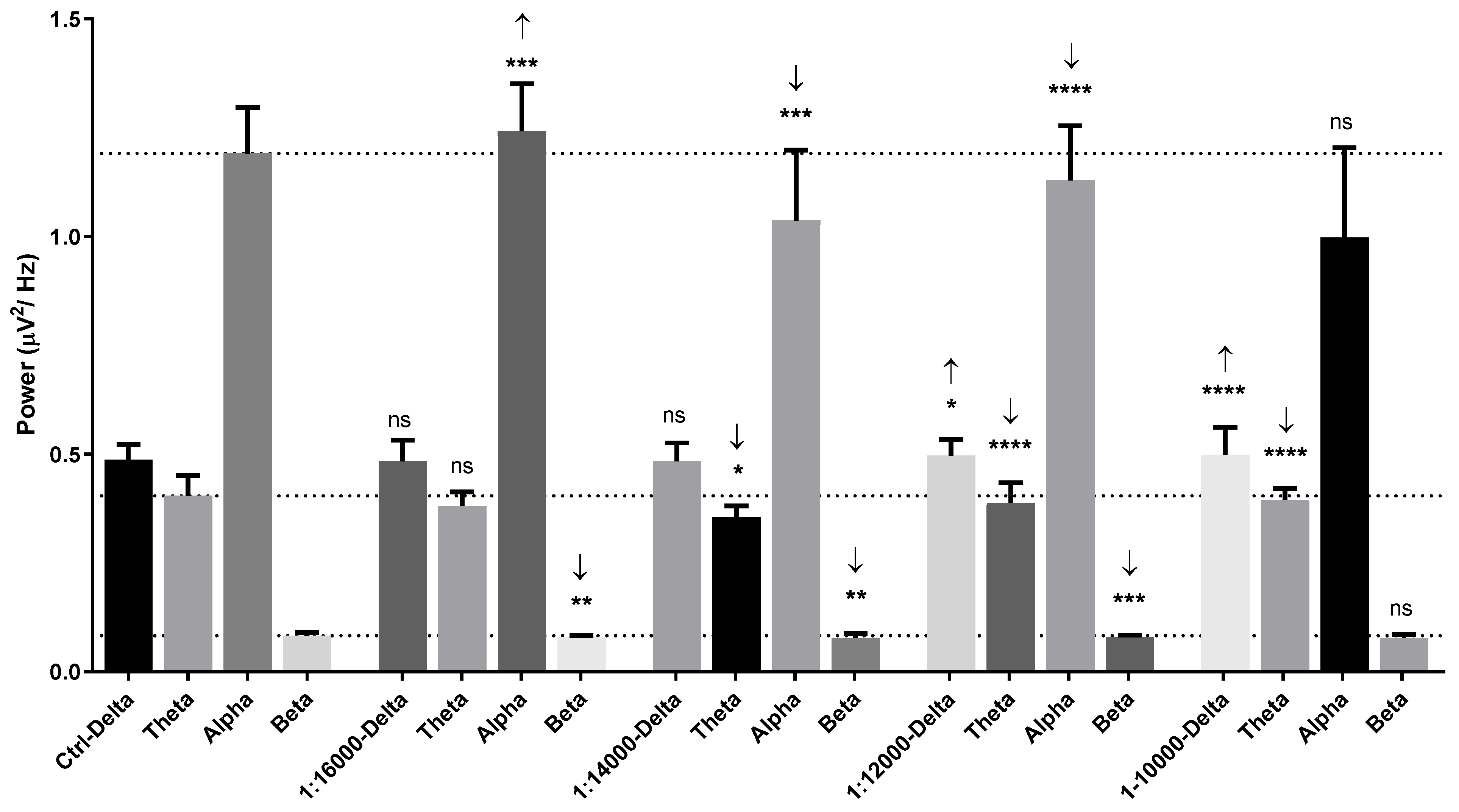
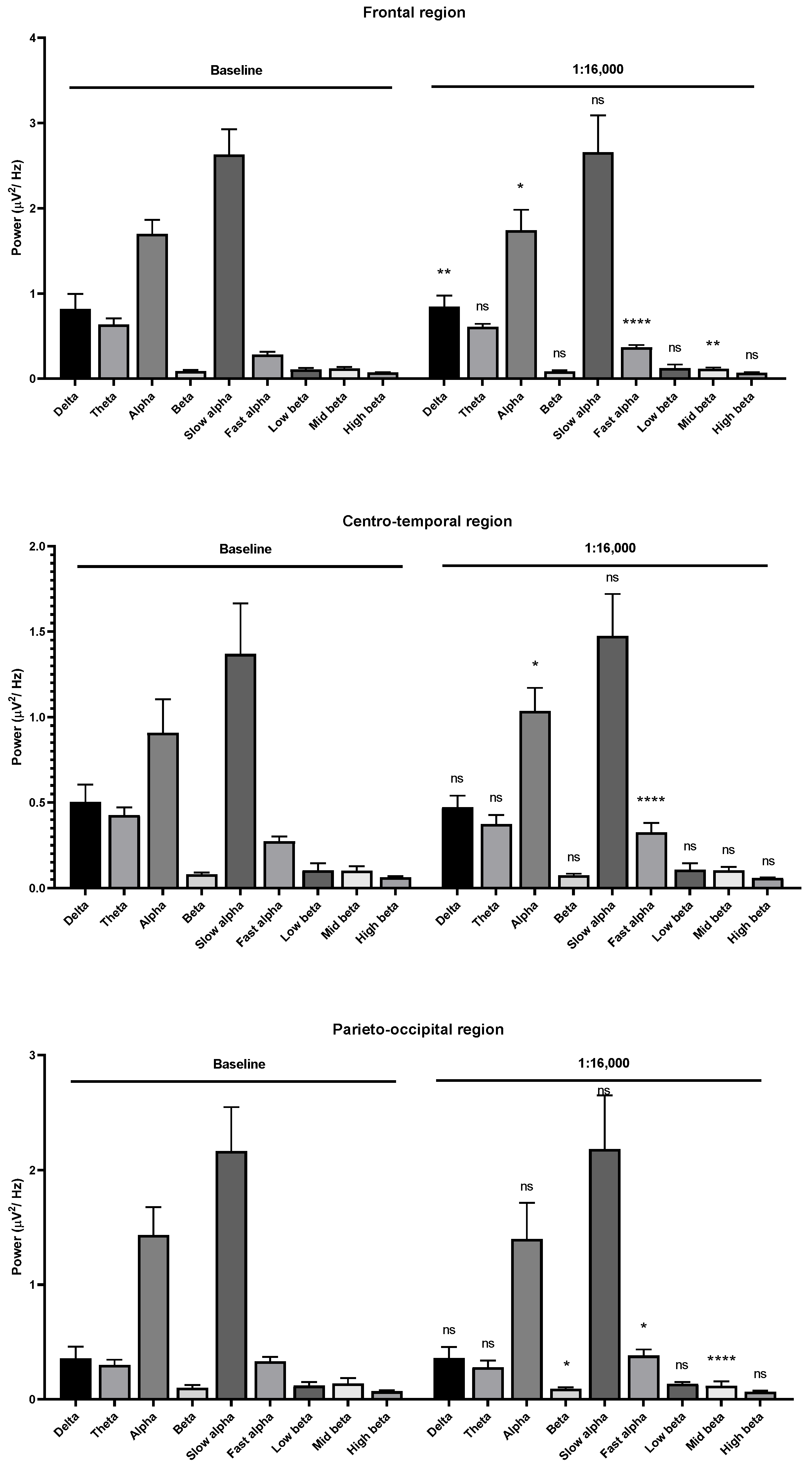
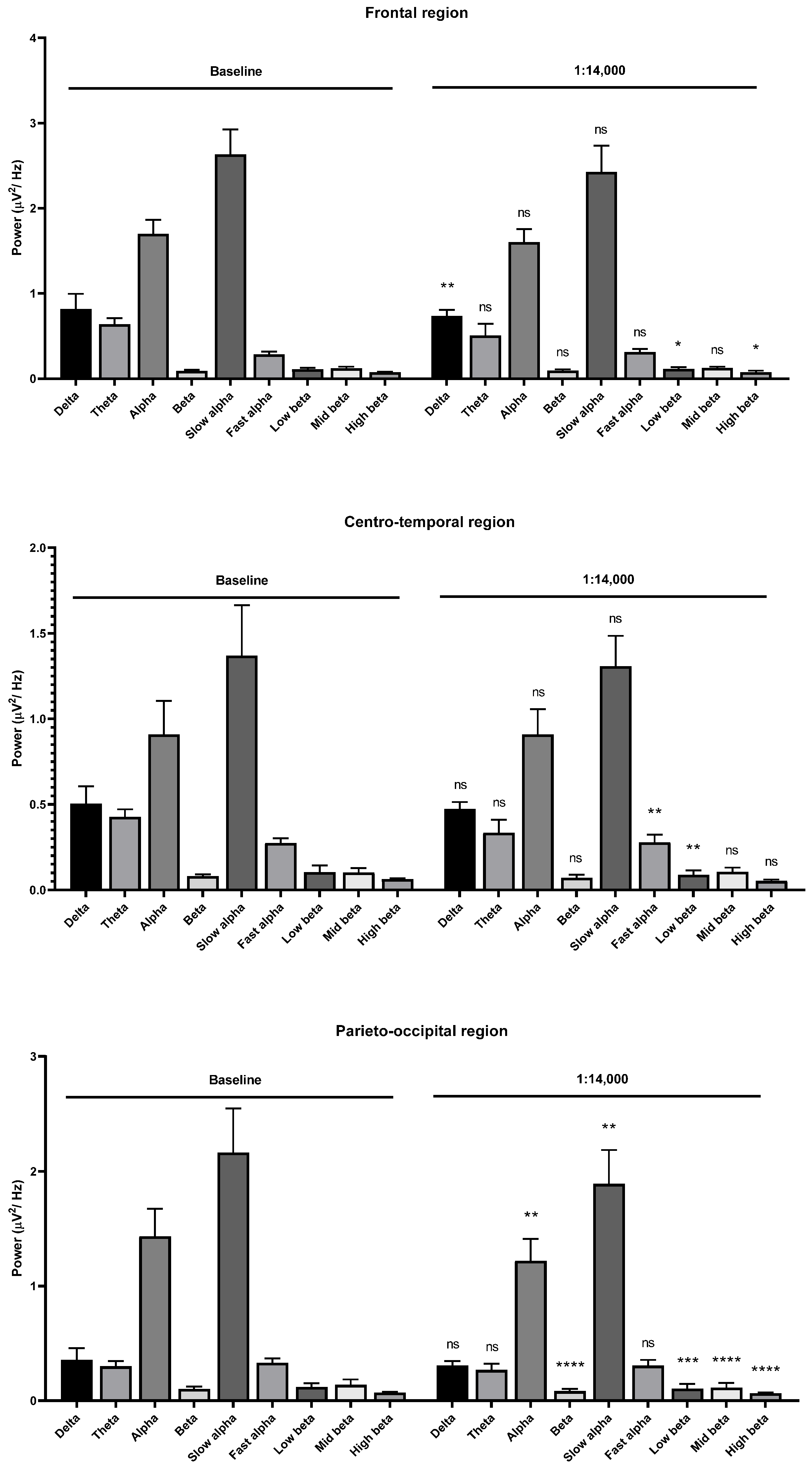

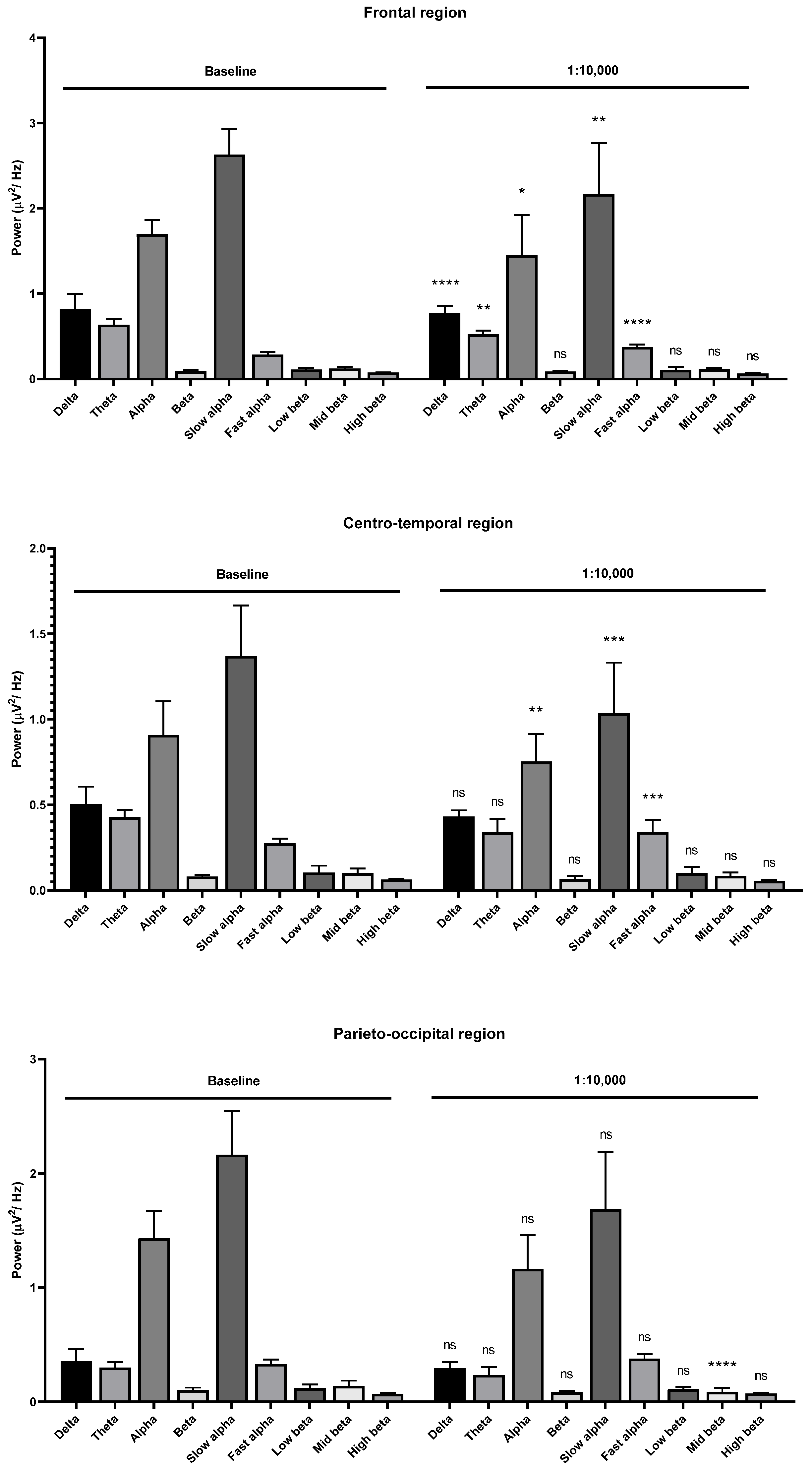
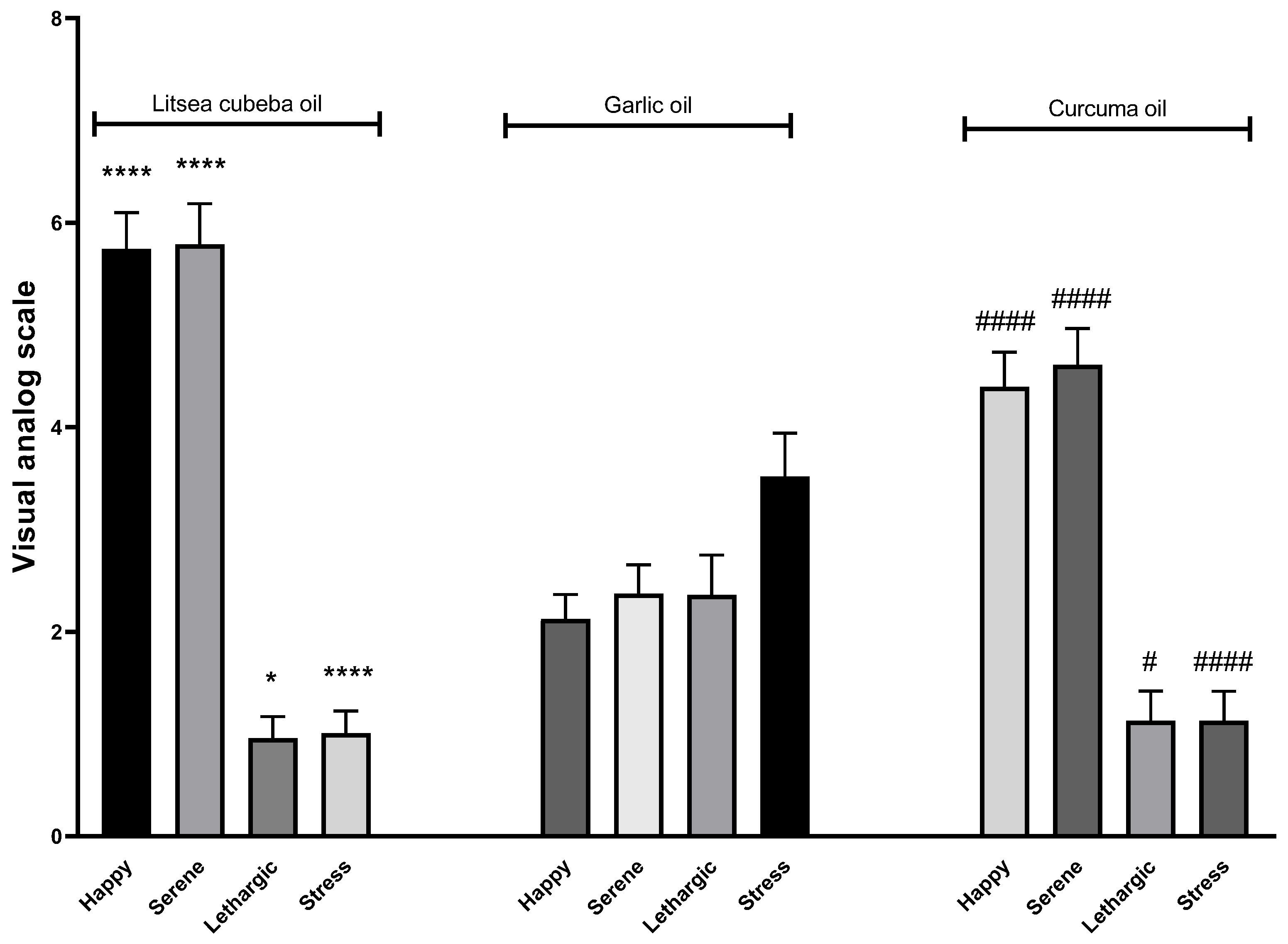

| RT Min | % (Area) | Compound |
|---|---|---|
| 4.99 | 0.07 | α-Thujene |
| 5.12 | 2.57 | Pinene |
| 5.38 | 0.46 | Camphene |
| 5.71 | 2.16 | Sabinene |
| 5.81 | 1.66 | β-pinene |
| 5.88 | 0.65 | 6-Methyl-5-hepten-2-one |
| 5.92 | 1.73 | β-Myrcene |
| 5.98 | 0.12 | 2,3-dihydro-1,8-cineole |
| 6.58 | 20.44 | dl-Limonene |
| 6.65 | 2.12 | 1,8-Cineole |
| 7.02 | 0.11 | γ-Terpinene |
| 7.44 | 0.10 | α-Terinolene |
| 7.63 | 1.24 | l-Linalool |
| 8.30 | 0.14 | Citral |
| 8.42 | 0.61 | Citronella |
| 8.83 | 1.15 | Cyclohexanone,5-methyl-2-(1-methylethenyl)-, trans- |
| 8.91 | 0.35 | Terpinen-4-ol |
| 9.12 | 0.49 | α-Terpineol |
| 9.50 | 0.59 | Geranyl Alcohol |
| 9.71 | 26.78 | β-Citral |
| 9.85 | 1.01 | Linalool |
| 10.12 | 33.36 | α-Citral |
| 11.64 | 0.09 | α-Cubebene |
| 12.25 | 0.93 | Trans-Caryophyllene |
| 13.21 | 0.13 | Bicyclogermacrene |
| Total | 99.07 |
| RT Min | % (Area) | Compound |
|---|---|---|
| 2.34 | 3.19 | Allyl methyl sulfide |
| 3.88 | 0.29 | 1,2-Dithiolane |
| 4.05 | 30.17 | Diallyl sulfide |
| 4.25 | 0.20 | n-Propyl trans-1-propenyl sulfide |
| 4.87 | 3.05 | Allyl methyl disulfide |
| 5.70 | 0.25 | Dimethyl trisulfide |
| 7.39 | 24.40 | Diallyl disulphide |
| 7.59 | 0.30 | Allyl propyl disulfide |
| 8.30 | 5.00 | Trisulfide, methyl 2-propenyl |
| 9.09 | 0.13 | 3-Vinyl-4H-1,2-dithiin |
| 9.47 | 0.73 | 3-Vinyl-1,2-dithiocyclohex-5-ene |
| 10.67 | 18.00 | Diallyl trisulfide |
| 10.83 | 0.31 | Isobutyl isothiocyanate |
| 11.78 | 0.91 | Dimethyl tetrasulphide |
| 12.57 | 0.23 | Dimethylthioformamide |
| 13.52 | 0.82 | 2-(2-thia-4-pentenyl)-1-thia-cyclohex-5-ene |
| 13.81 | 5.28 | Diallyl tetrasulphide |
| 14.28 | 0.15 | 3H-1,2,4-Triazole-3-thione, 4,5-dihydro-4-methyl- |
| 14.39 | 0.46 | Isobutyl isothiocyanate |
| 21.29 | 0.34 | Octasulfur |
| Total | 94.21 |
| Essential Oil | n | Age (Years) | Weight (kg) | Height (cm) | Body Mass Index (kg/m2) | Smell Test Score (10) | Handedness |
|---|---|---|---|---|---|---|---|
| Garlic | 10 | 21.60 ± 1.35 | 55.72 ± 9.59 | 159.10 ± 7.75 | 22.04 ± 3.77 | 7.90 ± 0.88 | Right |
| Litsea cubeba | 10 | 21.80 ± 1.75 | 50.89 ± 6.46 | 158.45 ± 6.20 | 20.44 ± 2.83 | 8.50 ± 0.97 | Right |
| Curcuma longa | 10 | 21.80 ± 0.42 | 53.50 ± 11.91 | 157.00 ± 3.83 | 21.64 ± 4.48 | 9.30 ± 0.82 | Right |
Publisher’s Note: MDPI stays neutral with regard to jurisdictional claims in published maps and institutional affiliations. |
© 2021 by the authors. Licensee MDPI, Basel, Switzerland. This article is an open access article distributed under the terms and conditions of the Creative Commons Attribution (CC BY) license (https://creativecommons.org/licenses/by/4.0/).
Share and Cite
Sattayakhom, A.; Songsamoe, S.; Yusakul, G.; Kalarat, K.; Matan, N.; Koomhin, P. Effects of Thai Local Ingredient Odorants, Litsea cubeba and Garlic Essential Oils, on Brainwaves and Moods. Molecules 2021, 26, 2939. https://doi.org/10.3390/molecules26102939
Sattayakhom A, Songsamoe S, Yusakul G, Kalarat K, Matan N, Koomhin P. Effects of Thai Local Ingredient Odorants, Litsea cubeba and Garlic Essential Oils, on Brainwaves and Moods. Molecules. 2021; 26(10):2939. https://doi.org/10.3390/molecules26102939
Chicago/Turabian StyleSattayakhom, Apsorn, Sumethee Songsamoe, Gorawit Yusakul, Kosin Kalarat, Narumol Matan, and Phanit Koomhin. 2021. "Effects of Thai Local Ingredient Odorants, Litsea cubeba and Garlic Essential Oils, on Brainwaves and Moods" Molecules 26, no. 10: 2939. https://doi.org/10.3390/molecules26102939
APA StyleSattayakhom, A., Songsamoe, S., Yusakul, G., Kalarat, K., Matan, N., & Koomhin, P. (2021). Effects of Thai Local Ingredient Odorants, Litsea cubeba and Garlic Essential Oils, on Brainwaves and Moods. Molecules, 26(10), 2939. https://doi.org/10.3390/molecules26102939






